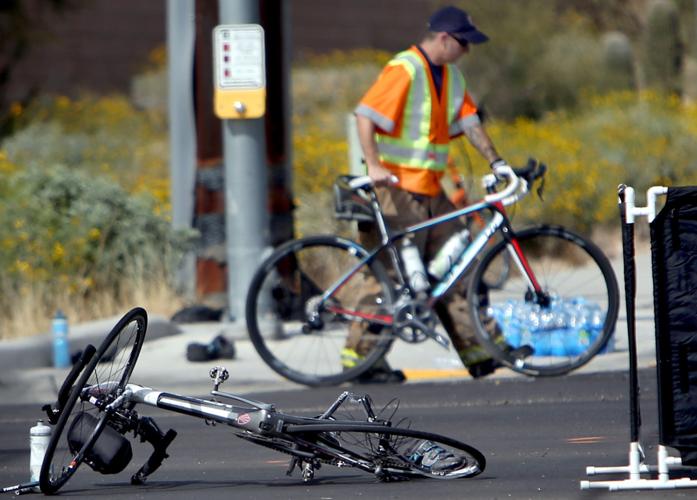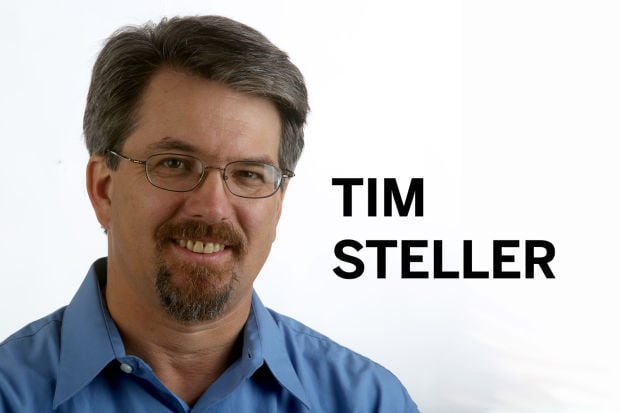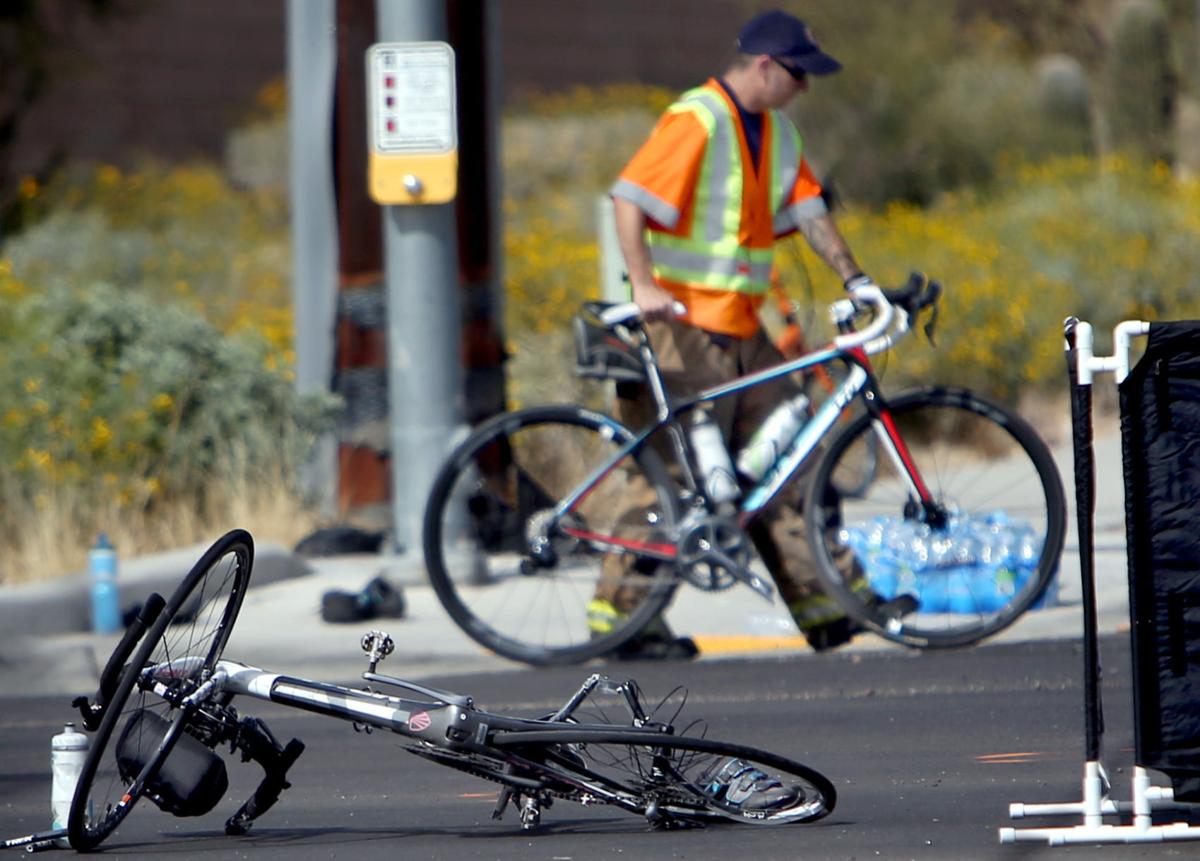Tucson has a lot to brag about as a bicycling city — the 50-miles of The Loop, long road-rides outside town, mountain-bike trails and, of course, the tough climb of the Catalina Highway.
But when we promote Tucson as a bicycle destination, we maybe should include a pharmaceutical-style disclaimer:
“The side effects of bicycling around Tucson may include serious injury or death.”
That’s because, as good as we are at creating bicycle culture and infrastructure, we just don’t have the driving habits or laws to match.
This was demonstrated again Thursday in one of the most tragic car-vs.-bicycle crashes out of way too many I’ve heard of over 19 years in this town. A group of 10 bicyclists, mostly tourists from Santa Fe — that is, people who came here specifically to ride their bikes — was stopped at a light on the northwest side, at North La Cañada and West Hardy Road.
They were in a bike lane when a pickup truck plowed into them from behind. Two died and one was in critical condition.
I’m not sure why this crash hit me harder than so many others. In January, Patricia Lyon-Surrey, a Vermont woman biking on East Sunrise Road, was struck and killed by an 89-year-old motorist who simply drove into her when merging from East Skyline. She was in a bicycle lane.
In February, a bicyclist was in the bike lane along South Craycroft Road, riding north near East 25th Street, when a driver plowed into him from behind. The driver, Troy Gosnell, drove away but was later arrested, authorities said.
These cases are part of the rhythm of life and death around here, one occurring every month or so. But the one on Thursday was just so awful, perhaps because these were older visitors who were members of a bicycling club and had picked Tucson. They were our guests.
How guilty we should feel about these cases depends in part on how dangerous Tucson really is for bicyclists, compared with the best cycling cities. One answer appears to be, we’re not good.
In 2012, Tucson officials applied to raise the area’s bicycle-friendliness ranking from gold-level to platinum, the highest honor. Tucson and eastern Pima County lost out in part because of our high rate of crashes.
The League of American Bicyclists, explaining its decision, noted that in platinum-ranked cities, the average number of bicycle-automobile crashes per 10,000 daily bike commuters is 64. In the Tucson area, the equivalent number is 212.
The number of bicyclist deaths in motor vehicle crashes is 0.42 per 10,000 daily bike commuters in the platinum-ranked cities. In the Tucson area, that figure is 2.32.
“The numbers are very high and must be significantly reduced to be considered a platinum-level bicycle friendly community,” the evaluation said.
The Tucson-Pima Bicycle Advisory Committee has applied again for platinum status, and should get the result in the next few months. Unfortunately, the city’s sprawling layout works against us.
It may be counterintuitive, but our big, wide streets outside the city’s older core seem to be part of the problem. It’s all a question of speed.
“The fatalities are happening generally outside of the city,” said Michael McKisson, an assistant professor of journalism at the University of Arizona who runs a local bike-news website called bicycletucson.com. “They’re in areas where there’s not a lot of stop-and-go traffic, so people really open up.”
The opposite phenomenon plays out in places like North Mountain Avenue, a major bicycle-commuter route to the UA. The city has gradually built up buffers between cars and cyclists. Those barriers, plus the sheer number of cyclists creating visibility, seem to have reduced crashes.
Elsewhere, rear-end crashes seem to be getting ominously more common. Brendan Lyons, who was struck from behind on East Sunrise Drive in 2013, has responded by becoming a campaigner for bicycle and auto safety.
He lambastes the Legislature for refusing to make texting-while-driving and related behaviors a crime. The fine for seriously injuring a cyclist, he pointed out, is $500. For killing one, it’s $1,000. In other words, unless you’re committing another crime, like hit and run, when you crash into a cyclist, you’re likely to get off relatively easily in Arizona, if you have any consequences at all.
“We need to recognize that human lives are lost and the accountability is a slap on the wrist,” he told me.
In Thursday’s case, investigators are saying the driver, 28-year-old Brian Lynch, was impaired — on meth and marijuana, Sheriff Chris Nanos told me. But that may not be the only reason for drifting into the bike lane and smashing into the group.
“We’re looking at his phone,” Nanos said. “Was it distracted driving, or was it both?”
It’s tempting to want to throw up our hands and try to segregate cyclists and motorists altogether. But not only would that be too costly, it would also infringe on the rights of cyclists to use the same roads cars do, to risk their lives for the ride if they so choose.
The Loop helps. It’s about 50 miles of bike trails that rarely intersect with motorized traffic.
But that’s not a good choice for road riders who get up to high speeds.
Those riders, like Ralph Phillips, owner of Fair Wheel Bikes, simply have to choose their routes carefully and weigh the risks. Phillips started the weekly “Shootout” rides that are done by strong cyclists. This time of year, Phillips told me, there are so many riders in town, he breaks them into two groups of about 100 each. And he carefully picks routes and times to try to avoid traffic.
“This time of year, we have a lot of visiting athletes from around the world,” he said.
I used to be excited to hear that kind of news — world-class athletes in town to train. Now I worry that we’ll lose more of them to Tucson’s drivers.
But there is only one choice — to keep building the infrastructure, teaching drivers and cyclists to stay apart, and enforcing the law.
Matt Zoll, Pima County’s bicycle and pedestrian program manager, said heavy traffic enforcement in Oro Valley seems to have made the streets safer for cyclists. And Nanos, the sheriff, is considering pursuing an anti-texting-and-driving ordinance for Pima County, since the state won’t do it.
“I don’t think we shut down our cycling efforts,” he said. “We just need to do a better job of taking care of them.”
It’s our obligation, if we’re going to keep selling Tucson as a bicycling destination.







